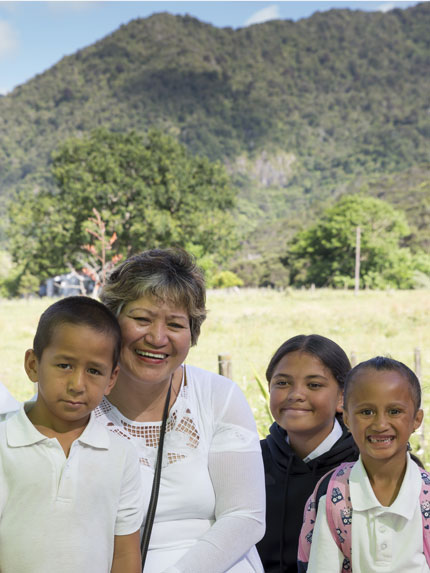Mina Pomare-Peita

Te Kura Taumata o Panguru, Panguru School, has about 90 pupils from year one to 15; it sits at the end of a long curving driveway with its back to a field of green and a forested mountain.
It’s very remote and that is a challenge.
“We have to be problem solvers here,” says Mina Pomare-Peita, the school principal, waving her arms in expansive circles to indicate remoteness. “I’m not sending my children out to be failures. We have to be resourceful. If we need something I just get out there and get it.
“We have a high percentage of students who move through to tertiary education. It gives them more choices. But we want those choices to be practical and related to work opportunities, some here in Northland.”
Mina runs an innovative programme that includes such things as an annual science camp and ‘gamification’ – using games for education.
“We bring in professional groups to assist in learning. For example, we have GNS, which is a government research institution on geology. We did an 11-day camp with expert scientists.
That's a way of getting professional expertise into the school, delivering specialist subjects that are really important to Northland.”
But one problem that urgently needed solving was all about connections. For most, the internet is a normal part of everyday life. But two years ago, Panguru had no internet, and barely any cellphone coverage. Mina had to hang her phone out the window to see if she could connect to a network and felt lucky to get text messages once a day.
Mina applied for the school to be wired up through the government initiative N4L (Network for Learning). N4L delivers the promise to connect schools across New Zealand with fast and reliable internet, regardless of where they are.
“For us it’s all about equity,” says Carolyn Stuart, Deputy Chief Executive: Education, for N4L. “Panguru were already at a huge disadvantage because of their location. Because they’re so remote, an internet connection is a huge learning enabler.”
“We’re a school that's about 21st century skills,” Mina says. “And one of those 21st century skills is about information and communication technologies. Pen and paper is redundant for my students. It's about using a device to connect.
“We want to have access to anything that will help us learn.”
Panguru may be on the edge of remote. But now its reach circumnavigates the globe, giving each child a chance to communicate and collaborate with others, to build critical social networks and raise awareness.
“We want to ensure three things for Māori: we want to be normal, healthy and have access.”
Reported by Chris van Ryn for our AA Directions Autumn 2018 issue
